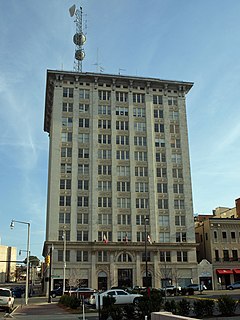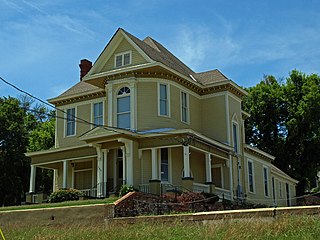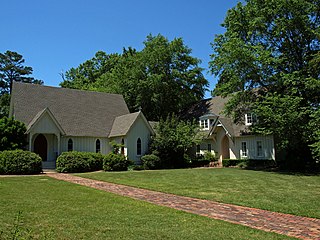
This is a list of buildings, sites, districts, and objects listed on the National Register of Historic Places in Alabama.

This is a list of the National Register of Historic Places listings in Baldwin County, Alabama.

This is a list of the National Register of Historic Places listings in Montgomery County, Pennsylvania.

The Bell Building is an office building located in downtown Montgomery, Alabama. It was built in 1907 by local businessman Newton J. Bell, and was the tallest building in Montgomery at the time. It was added to the National Register of Historic Places in 1981. The height of the building is 187 feet.

The Alabama State University Historic District is a 26-acre (11 ha) historic district at the heart of the Alabama State University campus in Montgomery, Alabama. It contains eighteen contributing buildings, many of them in the Colonial Revival style, and one site. The district was placed on the Alabama Register of Landmarks and Heritage on August 25, 1994, and the National Register of Historic Places on October 8, 1998.

Winter Place is a historic complex of two conjoined houses and three outbuildings in Montgomery, Alabama.

The Stone Plantation, also known as the Young Plantation and the Barton Warren Stone House, is a historic Greek Revival-style plantation house and one surviving outbuilding along the Old Selma Road on the outskirts of Montgomery, Alabama. It was added to the Alabama Register of Landmarks and Heritage on September 28, 2000 and to the National Register of Historic Places on December 31, 2001.

The Brame House, also known as the Brame-Cody-Neal House, was a historic Classical Revival-style house in Montgomery, Alabama. The two-story frame house was built in 1897 by W.W. Brame. It was added to the Alabama Register of Landmarks and Heritage on January 29, 1980 and to the National Register of Historic Places on September 17, 1980. Its fate is unclear, although it no longer stands at the address listed on the registers.

The Tankersley Rosenwald School, also known as the Tankersley Elementary School, is a historic American Craftsman-style school building in Hope Hull, Alabama, a suburb of Montgomery. This Rosenwald School building was built in 1922 to serve the local African American community. The money to build the school was provided, in part, by the Julius Rosenwald Fund. It was added to the Alabama Register of Landmarks and Heritage on June 26, 2003 and to the National Register of Historic Places as a part of The Rosenwald School Building Fund and Associated Buildings Multiple Property Submission on January 22, 2009.

The Jefferson Franklin Jackson House, commonly known as the Jackson-Community House, is a historic Italianate-style house in Montgomery, Alabama. It was added to the Alabama Register of Landmarks and Heritage on July 21, 1978 and to the National Register of Historic Places on May 17, 1984.

The Cleveland Court Apartments 620–638 is a historic apartment building in the Cleveland Court Apartment Complex in Montgomery, Alabama. It is significant to the history of the modern Civil Rights Movement in the United States. Unit 634 was home to civil rights activist Rosa Parks, her husband Raymond, and her mother, Leona McCauley, during the Montgomery Bus Boycott from 1955 to 1956. The building was placed on the Alabama Register of Landmarks and Heritage on March 30, 1989 and the National Register of Historic Places on October 29, 2001.

The Cottage Hill Historic District is a 42-acre (17 ha) historic district in Montgomery, Alabama. It is roughly bounded by Goldthwaite, Maxwell, Holt, and Clayton streets and contains 116 contributing buildings, the majority of them in the Queen Anne style. The district was placed on the Alabama Register of Landmarks and Heritage on April 16, 1975 and the National Register of Historic Places on November 7, 1976.

Grace Episcopal Church is a historic Episcopal church in Mount Meigs, Alabama. The Carpenter Gothic structure was built in 1892. The building was placed on the Alabama Register of Landmarks and Heritage on January 29, 1980 and the National Register of Historic Places on February 19, 1982.

The Patrick Henry Brittan House, also known as the Brittan-Dennis House, is a historic Italianate style house in Montgomery, Alabama. The one-story brick house was completed in 1858 by Patrick Henry Brittan, 10th Secretary of State of Alabama. It was added to the National Register of Historic Places on December 13, 1979. The building is located at 507 Columbus Street.

The Gerald–Dowdell House is a historic Italianate style house in Montgomery, Alabama. The two-story frame and masonry raised-cottage was built in 1854–55 for Perley and Camilla Gerald. Perley Gerald was born in New York and migrated to Alabama in 1829. The house was added to the National Register of Historic Places on April 28, 1980. It was extensively restored in 2000 and now houses the law offices of Wilkerson and Bryan, P.C.
The Harrington Archaeological Site, also known as the Alabama Archaeological Survey 1 Mt 231, is the site of a Native American settlement along Catoma Creek in modern Montgomery County, Alabama. The site contains numerous artifacts from the Calloway Phase of the Woodland period, including potsherds, bone tools, and plant and animal remains.
The Jere Shine Site (1MT6) is an archaeological site near the confluence of the Tallapoosa and Coosa rivers in modern Montgomery County, Alabama. Based on comparison of archeological remains and pottery styles, scholars believe that it was most likely occupied from 1400–1550 CE by people of the South Appalachian Mississippian culture. In addition to its Mississippian-era Shine I-phase, it is the largest settlement associated with the Shine II-phase of the lower Tallapoosa River. The 35-acre (14.2 ha) site contains five platform mounds and numerous shell middens. It was added to the National Register of Historic Places on December 8, 1978.

The North Lawrence–Monroe Street Historic District was a 2.8-acre (1.1 ha) historic district in Montgomery, Alabama. It comprised 132-148, 216, and 220 Monroe Street and 14, 22, 28-40, and 56 North Lawrence Street, containing a total of six contributing buildings. These buildings were significant in that they housed African American businesses during the era of segregation, making this a commercial center for African Americans in Montgomery. The businesses played a supporting role during the Montgomery Bus Boycott in 1955–56 by providing dispatch and pick-up services. The district was placed on the National Register of Historic Places on August 30, 1984. The entire block was subsequently demolished in the mid-1990s to allow construction of a parking deck for the RSA Tower.

Frank Lockwood (1865-1935) was one of Montgomery, Alabama's leading architects.




















